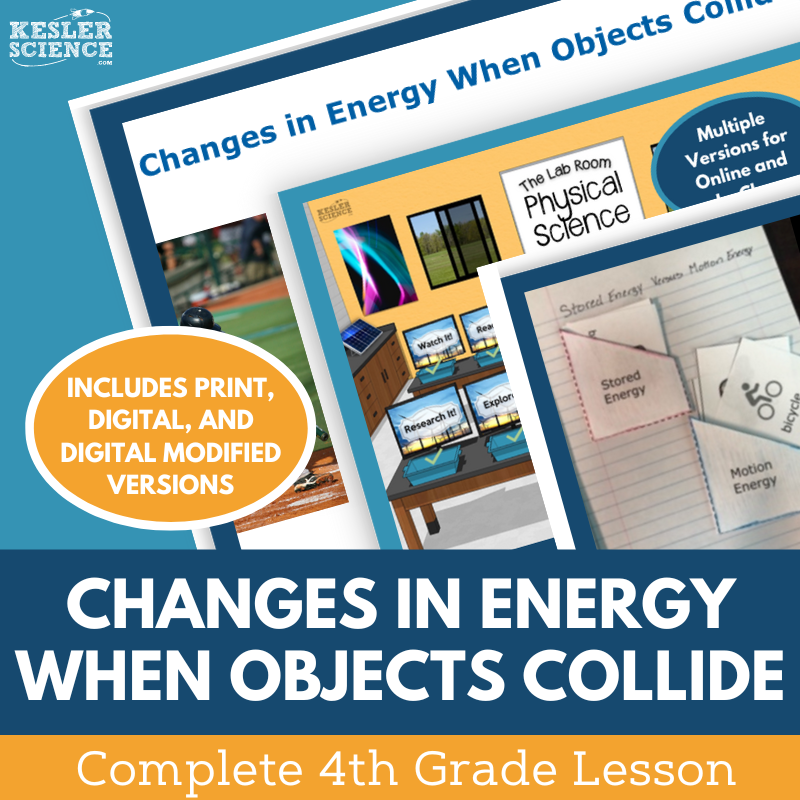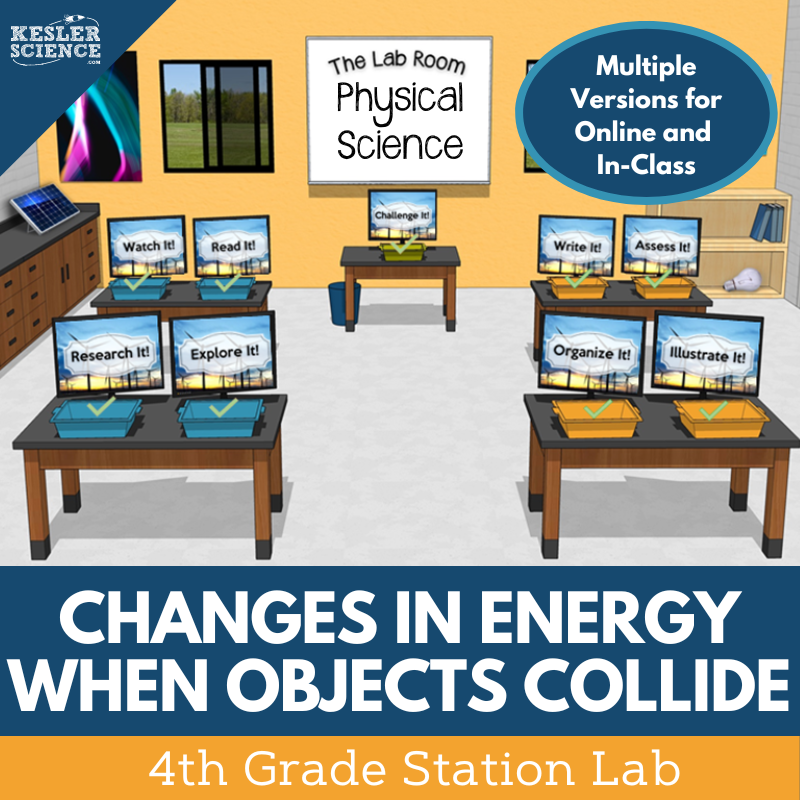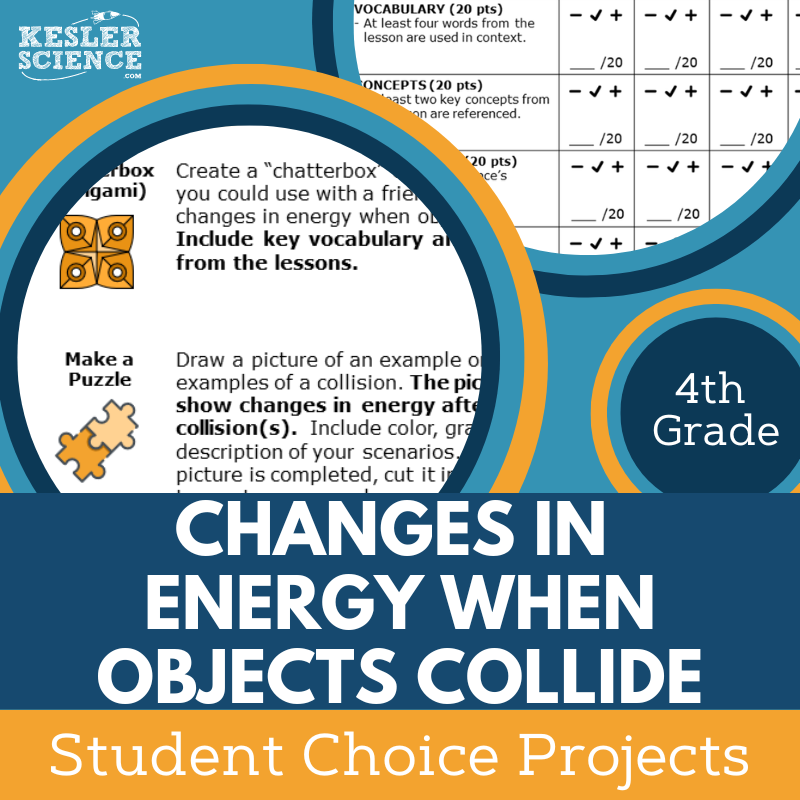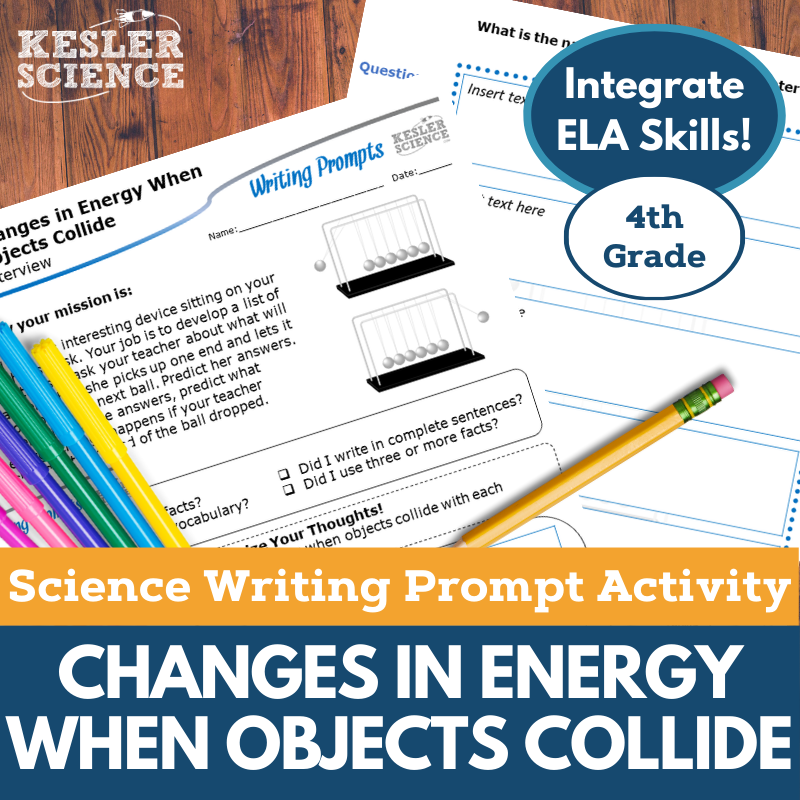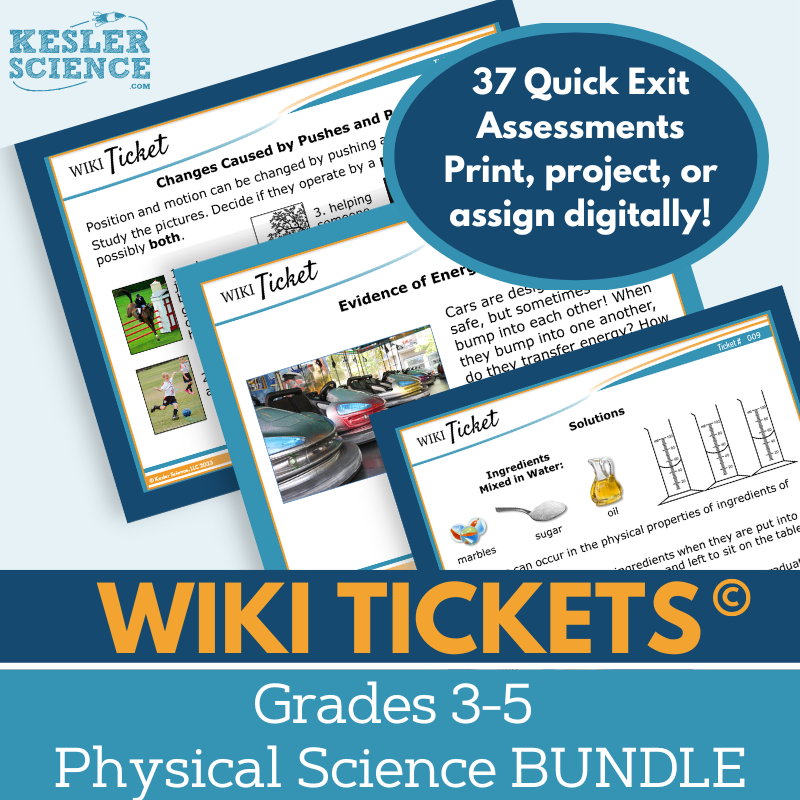Changes in Energy When Objects Collide Activities for 4th Grade Science
The Kesler Science Changes in Energy When Objects Collide resources provide an engaging, student-centered approach to exploring energy transfer during collisions. The resources below will give students a comprehensive understanding of how energy changes when objects collide. All of the following materials are also included in the Kesler Science Membership.
The Kesler Science Changes in Energy When Objects Collide 4th Grade Complete 5E Lesson is designed to make lesson planning a breeze with everything you need for an engaging, multi-day physical science unit. Students explore essential questions about energy transfer during collisions, using differentiated and multimodal materials that keep them engaged. With flexible formats (printable and digital), editable PowerPoints, and Spanish translations, this lesson is easy to adapt to your classroom needs.
This lesson follows the 5E Model—Engagement, Exploration, Explanation, Elaboration, and Evaluation—with comprehensive resources at each stage. From objectives and word wall cards to student-led stations and interactive notebook templates, every part of the lesson promotes active learning. Students will engage with hands-on activities, read, research, and watch videos, then demonstrate their understanding through writing, organizing, and illustrating their knowledge.
The lesson also includes extension activities for early finishers, editable presentations for differentiation, and assessment tools to evaluate student progress. Perfect for in-person or virtual learning, this complete lesson is designed to save teachers prep time while ensuring all students can engage with and master the content.
The Kesler Science Changes in Energy When Objects Collide 4th Grade Complete 5E Lesson is designed to make lesson planning a breeze with everything you need for an engaging, multi-day physical science unit. Students explore essential questions about energy transfer during collisions, using differentiated and multimodal materials that keep them engaged. With flexible formats (printable and digital), editable PowerPoints, and Spanish translations, this lesson is easy to adapt to your classroom needs.
This lesson follows the 5E Model—Engagement, Exploration, Explanation, Elaboration, and Evaluation—with comprehensive resources at each stage. From objectives and word wall cards to student-led stations and interactive notebook templates, every part of the lesson promotes active learning. Students will engage with hands-on activities, read, research, and watch videos, then demonstrate their understanding through writing, organizing, and illustrating their knowledge.
The lesson also includes extension activities for early finishers, editable presentations for differentiation, and assessment tools to evaluate student progress. Perfect for in-person or virtual learning, this complete lesson is designed to save teachers prep time while ensuring all students can engage with and master the content.
The Kesler Science Changes in Energy When Objects Collide Station Lab offers a dynamic, student-led approach to learning about physical science concepts. With eight differentiated activities and a challenge station for early finishers, students can explore and predict outcomes of energy changes during collisions. This modular, hands-on lab saves teachers prep time while allowing students to take charge of their learning, either individually or in small groups.
The nine stations provide varied ways to encounter new concepts, including hands-on demos, research, reading passages, and videos. Students can interact with the material in multiple formats, such as PowerPoint or Google Slides, fostering an engaging, multimodal learning environment. Each station promotes critical thinking and application, helping students grasp key science concepts through active participation.
With both input and output stations, students have opportunities to organize, illustrate, write, and assess their understanding of energy changes. The digital version allows for easy virtual integration, and the bonus "Challenge It!" station provides extra activities for advanced learners. This adaptable station lab offers a comprehensive, engaging learning experience suitable for both in-person and remote classrooms.
The Kesler Science Changes in Energy When Objects Collide Station Lab offers a dynamic, student-led approach to learning about physical science concepts. With eight differentiated activities and a challenge station for early finishers, students can explore and predict outcomes of energy changes during collisions. This modular, hands-on lab saves teachers prep time while allowing students to take charge of their learning, either individually or in small groups.
The nine stations provide varied ways to encounter new concepts, including hands-on demos, research, reading passages, and videos. Students can interact with the material in multiple formats, such as PowerPoint or Google Slides, fostering an engaging, multimodal learning environment. Each station promotes critical thinking and application, helping students grasp key science concepts through active participation.
With both input and output stations, students have opportunities to organize, illustrate, write, and assess their understanding of energy changes. The digital version allows for easy virtual integration, and the bonus "Challenge It!" station provides extra activities for advanced learners. This adaptable station lab offers a comprehensive, engaging learning experience suitable for both in-person and remote classrooms.
The Kesler Science Changes in Energy When Objects Collide Student Choice Projects give 4th grade students the freedom to choose a project that suits their learning style. With six different project options plus a “design your own” option, students can personalize their project and engage in creative learning. A flexible grading rubric allows for assessments from teachers, peers, or self-assessment.
These dynamic projects are designed for flexibility and accommodate a wide range of student needs. Teachers can adjust the rubric to align with specific grading requirements, while multimodal choices offer personalized ways for students to demonstrate their understanding. Differentiated project options support remediation or challenge students seeking additional opportunities to extend their learning.
The projects utilize common classroom supplies such as paper, markers, and scissors, and many can be completed digitally. The resources are adaptable to various learning environments and cater to a variety of student abilities, making them a versatile tool for enhancing both science and creativity.
The Kesler Science Changes in Energy When Objects Collide Student Choice Projects give 4th grade students the freedom to choose a project that suits their learning style. With six different project options plus a “design your own” option, students can personalize their project and engage in creative learning. A flexible grading rubric allows for assessments from teachers, peers, or self-assessment.
These dynamic projects are designed for flexibility and accommodate a wide range of student needs. Teachers can adjust the rubric to align with specific grading requirements, while multimodal choices offer personalized ways for students to demonstrate their understanding. Differentiated project options support remediation or challenge students seeking additional opportunities to extend their learning.
The projects utilize common classroom supplies such as paper, markers, and scissors, and many can be completed digitally. The resources are adaptable to various learning environments and cater to a variety of student abilities, making them a versatile tool for enhancing both science and creativity.
The Kesler Science Changes in Energy When Objects Collide Science and ELA Integrated Writing Activity allows 4th grade students to dive into the concept of energy changes during collisions. Through an engaging interview writing format, students demonstrate their understanding of scientific principles while practicing their writing skills. This interactive exercise encourages students to expand their reasoning and communication abilities.
Designed for both virtual and classroom settings, this resource provides flexibility with multiple formats, including projection, digital, and printable options. The activity aligns with TEKS and NGSS standards, making it a valuable tool for reinforcing science concepts and enhancing literacy skills. Teachers can easily integrate the resource into their existing curriculum with minimal preparation.
Ideal for differentiated learning, the activity can be used for various purposes such as formative assessments, student choice projects, extra credit, or even as make-up work. The ready-to-use teacher directions and rubrics streamline the grading process, while the inclusion of self-checks and pre-writing strategies supports student growth throughout the exercise.
The Kesler Science Changes in Energy When Objects Collide Science and ELA Integrated Writing Activity allows 4th grade students to dive into the concept of energy changes during collisions. Through an engaging interview writing format, students demonstrate their understanding of scientific principles while practicing their writing skills. This interactive exercise encourages students to expand their reasoning and communication abilities.
Designed for both virtual and classroom settings, this resource provides flexibility with multiple formats, including projection, digital, and printable options. The activity aligns with TEKS and NGSS standards, making it a valuable tool for reinforcing science concepts and enhancing literacy skills. Teachers can easily integrate the resource into their existing curriculum with minimal preparation.
Ideal for differentiated learning, the activity can be used for various purposes such as formative assessments, student choice projects, extra credit, or even as make-up work. The ready-to-use teacher directions and rubrics streamline the grading process, while the inclusion of self-checks and pre-writing strategies supports student growth throughout the exercise.
The Kesler Science Physical Science WIKI Tickets provide engaging formative assessments for 3rd–5th grade science. This set includes 37 exit tickets aligned to NGSS and TEKS, covering chemistry, energy, force, and motion topics.
Each assessment comes in five formats: a full-screen display for projection, three printable handout sizes, and an interactive digital version compatible with PowerPoint and Google Slides. A table of contents file ensures easy standard alignment.
WIKI Tickets (“What I Know Is”) serve as exit tickets, bellringers, or quick checks for understanding, making them a versatile tool for both in-person and virtual learning environments.
The <Kesler Science Physical Science WIKI Tickets provide engaging formative assessments for 3rd–5th grade science. This set includes 37 exit tickets aligned to NGSS and TEKS, covering chemistry, energy, force, and motion topics.
Each assessment comes in five formats: a full-screen display for projection, three printable handout sizes, and an interactive digital version compatible with PowerPoint and Google Slides. A table of contents file ensures easy standard alignment.
WIKI Tickets (“What I Know Is”) serve as exit tickets, bellringers, or quick checks for understanding, making them a versatile tool for both in-person and virtual learning environments.
Year-Round Resources
These year-round activities will increase your students' understanding of many middle school science topics. All of these activities are also included in the Kesler Science Membership.
Visual Data & Graphing
You're not alone if your students struggle with understanding graphs, charts, and tables. It's a skill that takes an enormous amount of practice. This resource will help students build a strong foundation in analyzing data and creating their own data visualizations.
Bell Ringers and Warm-Ups
These middle school science bell ringers are an excellent way to engage your students as soon as they walk into your classroom. This comprehensive FULL YEAR resource includes everything you need to start off each science class with an interesting warm-up activity.
Review Board Games
Each game board has been carefully designed to keep students engaged. There are 10 different action spaces on each board and dozens of question cards. All of the actions are related to science concepts and keep the students motivated throughout the game.
Each game is ready to play. Simply print out the board and the cards and let the students enjoy reviewing nine different units.
Essential Questions
Below are the essential questions associated with the lessons and activities included in this unit. This topic is only one of more than 100 middle school science topics included in the Kesler Science Membership.
-
What happens to the energy in one object when it collides with another object?
-
What observations can we make that would show that energy is present when two objects collide?
Kesler Science Membership
Imagine never having to search for another middle school science lesson again. The membership gives you access to ALL of the Kesler Science products in one place (Yes, including everything above).
Say goodbye to long hours of lesson prep.

